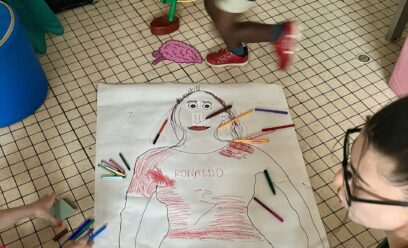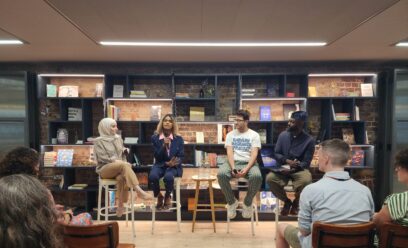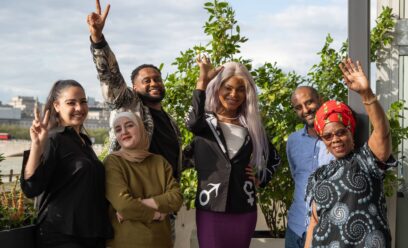We should all celebrate Nowruz, the holiday of spring and renewal
Posted by Elahe Ziai on March 17, 2022‘The UK has a proud history of welcoming thousands of refugees who celebrate Nowruz’: Community Outreach Officer Elahe Ziai explains why we should all be aware of Nowruz, the Farsi-speaking New Year.
Nowruz, also known as the Persian New Year, is not a religious holiday. It is rather a two-week celebration of new beginnings that has been enjoyed for thousands of years in many countries influenced by Persian culture. The festival marks the exact moment of the spring equinox, just as nature is coming to life, trees are sprouting green leaves and displaying pink and white blossoms. The cold season is over, and warmth is on its way.
The beauty of Nowruz is less about a single day and more about the joy of wiping away the dust, grime, and sadness of the old in order to start anew. So, before spring rolls in, we close the previous chapter with the feverish activity of housecleaning. In Farsi it means ‘house shaking’ as we clean every corner, ridding our homes of any unnecessary clutter and lingering grime that has settled over the past year. It is important to feel we are turning a new page with a blank sheet and welcoming our new year with sparkling homes and new, clean clothes, symbolising the triumph of good over evil and joy over sorrow.
Despite this hard work carried out by all family members, it is impossible not to enjoy the enthusiasm and energy filling the air. In Nowruz-celebrating countries, colourful markets are packed with eager shoppers and a full assortment of goods from new clothes, fresh fruits, sweets and nuts to fresh cut flowers, gorgeous hyacinths, potted plants, and goldfish, which represents life.
The Seven Things Table
And let’s not forget about the one widespread tradition, the preparation of the Nowruz table known as ‘Softreye haft-seen’ or the ‘seven things table’. It is a collection of seven items commencing with the sound ‘s’ symbolising a different hope for the new year, including:
Sabzeh: some kind of sprouting grass grown in the weeks leading up to the holiday and symbolise rebirth.
Senjed: sweet dry fruit of the lotus tree which symbolises wisdom.
Sib: apples symbolise beauty and health.
Seer: garlic symbolises medicine and good health.
Samanu: a sweet pudding made from wheat germ symbolises power and fertility.
Serkeh: vinegar for patience
Sumac: a spice made from crushed sour red berries symbolises sunrise and good conquering evil.
Alternative items like Sekkeh (coins) referring to wealth and prosperity or Saat (clock) referring to time can also be incorporated.
Once the seven cornerstones are set, the Haft-seen is yours to customise, and while these tables differ slightly from one family to another, the most common symbolic elements are: water, candles, mirrors, eggs, hyacinth, and goldfish. On the 13th day, known as ‘Nature’s Day,’ everyone celebrates by picnicking outdoors. This marks the end of the Nowruz holiday for another year. Nowruz is so important to all Iranians that they carry it with them in their hearts wherever they go.
What I love about Nowruz:
“In my heart you are the mirthful ray
You are the caring, though my companions they
Happy is the world with the Nowruz and with the Eid
You are both my Eid and my Nowruz today” – Rumi (13th-century Persian poet)
I moved from Iran to my current home in Glasgow. For me, Nowruz is a celebration of life, and it holds a special place in my heart and memories of being back home.
The events involved in Nowruz is a symbolic way of celebrating the triumph of light over darkness. With war, hunger, disease, ignorance, and poverty raging all around the world, I’d like to think spring and our new year will give us another opportunity to reflect on how we can make our world a better place to live; a beautiful place in which everyone is welcomed regardless of race, religion, and skin and eye colour – a place with love for all nations.
Why should Nowruz be more widely celebrated in the UK?
Working in the refugee sector requires a huge level of cultural competency. Working with people from all around the globe means increasing cultural awareness, sensitivity, and education. Cultural competence is essential to provide a quality service to culturally diverse client groups. The refugee and immigrant populations will benefit more from culturally informed interactions.
In order to best support our people and their integration we need a holistic approach. Integration is a two-way street meaning immigrants and the host society are both required to adapt to each other’s presence. One way to approach this street would be to take an interest in their food, language and most importantly culture.
The UK has a proud history of welcoming thousands of refugees who celebrate Nowruz, including a large Iranian diaspora, Farsi-speaking Afghans who were recently evacuated to the UK, and Kurds, among other nationalities.
Having the chance to work with so many refugees from Iran, Afghanistan, and Kurdistan, I have learned that when people must flee, they do not have a time to get a suitcase and grab what they care about. Sometimes they flee without even having a chance to say goodbye, and the only common things they all carry with them in their hearts are their memories, memories of their childhood, parents, families, festivals, and their New Years.
Refugees and migrants do not need our pity. In a world where one percent of the population is displaced, it is vital that kindness is not merely condescension. What they need is an active involvement in their process of integration which begins with curiosity and interest that makes newcomers feel more welcome.





